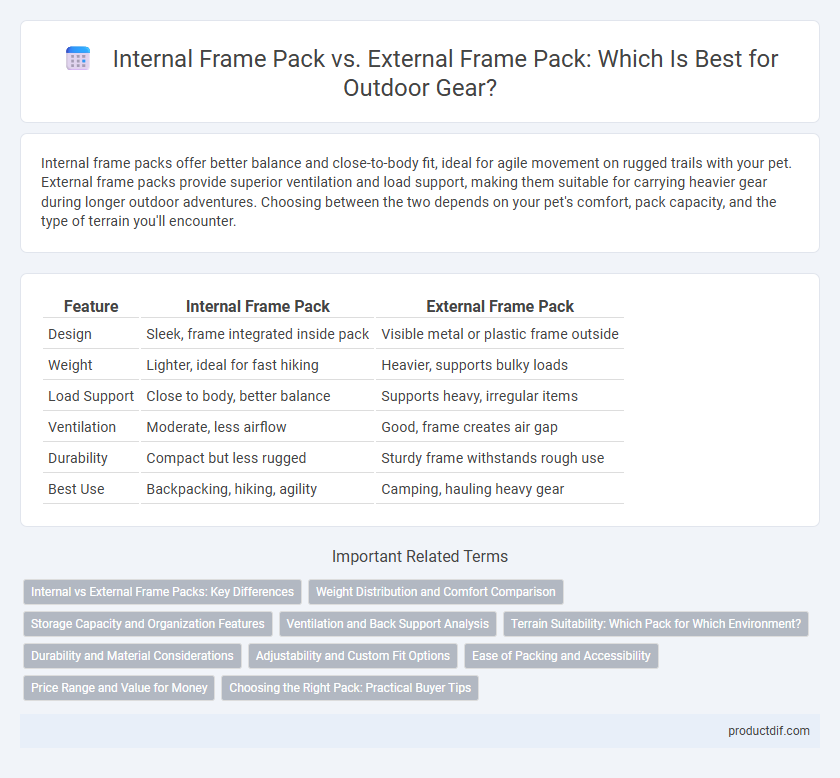Internal frame packs offer better balance and close-to-body fit, ideal for agile movement on rugged trails with your pet. External frame packs provide superior ventilation and load support, making them suitable for carrying heavier gear during longer outdoor adventures. Choosing between the two depends on your pet's comfort, pack capacity, and the type of terrain you'll encounter.
Table of Comparison
| Feature | Internal Frame Pack | External Frame Pack |
|---|---|---|
| Design | Sleek, frame integrated inside pack | Visible metal or plastic frame outside |
| Weight | Lighter, ideal for fast hiking | Heavier, supports bulky loads |
| Load Support | Close to body, better balance | Supports heavy, irregular items |
| Ventilation | Moderate, less airflow | Good, frame creates air gap |
| Durability | Compact but less rugged | Sturdy frame withstands rough use |
| Best Use | Backpacking, hiking, agility | Camping, hauling heavy gear |
Internal vs External Frame Packs: Key Differences
Internal frame packs feature a built-in support system that hugs the body closely, enhancing balance and stability on uneven terrain. External frame packs have a visible frame that extends outside the pack, allowing for better ventilation and easier attachment of bulky or oddly shaped gear. The choice between internal and external frame packs depends on the type of activity, with internal frames favored for agility and external frames preferred for heavy loads and extended hikes.
Weight Distribution and Comfort Comparison
Internal frame packs offer superior weight distribution by keeping the load close to the back, enhancing balance and comfort during rugged hikes. External frame packs distribute weight on an external structure, allowing better ventilation but often causing less stability on uneven terrain. For extended treks requiring agility, internal frame packs typically provide a more comfortable fit by conforming to the body's natural contours.
Storage Capacity and Organization Features
Internal frame packs typically offer streamlined storage capacity with compartments designed for balanced weight distribution and close-to-body stability, making them ideal for technical hikes and rugged terrain. External frame packs provide larger, more accessible storage with external attachment points and multiple pockets, enhancing organization and allowing easy access to bulky or irregular gear. Choosing between the two depends on the need for efficient load management versus maximizing carrying space and organizational versatility.
Ventilation and Back Support Analysis
Internal frame packs offer superior ventilation by contouring closely to the back, allowing improved airflow through mesh panels and reducing sweat buildup during strenuous hikes. External frame packs provide enhanced back support by distributing heavy loads more effectively with their rigid, external structure, which is ideal for carrying bulky gear over long distances. Choosing between the two depends on prioritizing breathability and close fit versus maximum load stability and support.
Terrain Suitability: Which Pack for Which Environment?
Internal frame packs excel in rugged, uneven terrains due to their snug fit and stability, making them ideal for mountainous or forested environments. External frame packs perform better on flat, open trails, offering better ventilation and heavier load distribution suited for long-distance treks on less technical terrain. Selecting the right pack depends on terrain type, with internal frames favored for technical hikes and external frames preferred for accessible, flatter landscapes.
Durability and Material Considerations
Internal frame packs utilize lightweight, flexible materials like aluminum or composite frames, enhancing durability through shock absorption and improved load stability. External frame packs often feature robust steel or aluminum frames, providing superior structural support for heavy loads but potentially increasing overall weight and reducing agility. Material advancements such as high-denier nylon and reinforced stitching significantly impact the longevity and wear resistance of both pack types in rugged outdoor environments.
Adjustability and Custom Fit Options
Internal frame packs offer superior adjustability and custom fit options through contoured frames and multiple suspension settings that conform closely to the hiker's back, enhancing comfort and stability on rugged terrain. External frame packs feature adjustable straps and hip belts but typically provide less precise fit customization due to their rigid frames designed for heavy loads and better ventilation. Choosing between the two depends on the need for tailored support in dynamic conditions versus load-bearing capacity with simpler adjustability.
Ease of Packing and Accessibility
Internal frame packs offer streamlined compartments and close-to-body design, making them easier to organize and access smaller items quickly during hikes. External frame packs provide larger, more open spaces ideal for bulky gear but may require unpacking multiple layers to reach items at the bottom. Hikers prioritizing easy access and efficient packing often prefer internal frame packs for their structured organization and accessibility.
Price Range and Value for Money
Internal frame packs typically range from $100 to $300, offering streamlined designs with enhanced load stability, making them ideal for technical terrain. External frame packs, priced between $80 and $250, provide superior ventilation and load capacity, delivering excellent value for extended hiking trips or heavy gear. Choosing between the two depends on balancing budget constraints with specific needs for comfort, durability, and load distribution.
Choosing the Right Pack: Practical Buyer Tips
Internal frame packs offer better balance and flexibility for rugged trails, making them ideal for backpackers prioritizing agility. External frame packs provide superior ventilation and load distribution, suitable for carrying heavy or irregular loads over long distances. Consider terrain, load type, and personal comfort when selecting between internal and external frame packs to ensure optimal support and endurance.
Internal Frame Pack vs External Frame Pack Infographic

 productdif.com
productdif.com